Entries in NextEra (4)
9/4/11 Like a bad neighbor, NextEra is there and tearing apart another rural community
From Michigan
BAY COUNTY WIND FARM PROJECT DIVIDES TOWNSHIP, TURNS NEIGHBOR AGAINST NEIGHBOR
SOURCE: www.mlive.com
September 4, 2011
By Andrew Dodson
“I really don’t like the situation. It’s friends, neighbors and even families against each other. It’s just too bad.”
MERRITT TWP. — A proposed $250 million wind farm project scattered through three counties is tearing one small Bay County farming community apart.
“It’s neighbor against neighbor, some family against family,” said Dave Schabel, Merritt Township supervisor.
“It’s going to alter our landscape here, so we better make sure we do the right thing.”
This past week, officials from Florida-based NextEra Energy and Ann Arbor-based Atwell Anderson Construction, which provides engineering services, met with Merritt Township officials to discuss possible site plans for 15 to 20 wind turbines in the township. The project in total will use 75 wind turbines to produce 120 megawatts of power, or enough to power 30,000 homes, in parts of Bay, Saginaw and Tuscola counties.
Two weeks ago, the Michigan Public Service Commission approved a contract worth $485 million for DTE Energy to buy power from the wind farm.
Schabel said he doesn’t know exact locations of the turbines, adding officials wouldn’t show him blueprints when they met Monday.
But landowners with at least 80 acres of land who were approached by NextEra for land leases said they have a rough idea where the 466-foot turbines would be installed on their property.
Not everyone is happy about it.
A group of about 20 residents, calling themselves the “Concerned Citizens of Merritt Township,” aren’t filing petitions but are going to residents’ homes providing information on what they call the dangers of wind farms.
According to the packet of information circulating through the township, the group’s effort is to “maintain our quality of life, which will be impacted by the establishment of a utility-scale wind turbine farm in our township.”
Brad Histed, a Merritt Township farmer, admits the hot-button issue has not only torn the community in two, but also his family.
He’s concerned about the noise the turbines could potentially create — what he describes as a continuous, low-buzzing sound — and opposes the wind farm.
His brother, Terry Histed, signed off a piece of his property to NextEra, supporting the project.
“It’s at the point now where I don’t even care what he does,” said Brad Histed. “All they see is dollar signs — I feel like my life and my sanity isn’t worth a couple thousand dollars.
“I haven’t talked to him in a while.”
Terry Histed, former president of the Bay County Farm Bureau, said the hostility started when the citizens group started going door-to-door.
“I really don’t like the situation,” he said. “It’s friends, neighbors and even families against each other. It’s just too bad.”
Neither NextEra officials nor other property owners have disclosed how much money property owners would receive if they sign a lease agreement, but one farmer said he wouldn’t have signed onto the project if it wasn’t worth it.
Harold VanDenBoom was one of the first township residents to sign a lease agreement.
“The nation as a whole needs more alternative energy sources,” said the 77-year-old retired farmer who has lived in the area since 1944.
“Listen, there are groups that oppose that (Consumers Energy) coal plant in Hampton Township, there are groups opposing these wind farms — what do people want?”
VanDenBoom said he will receive a lump sum during the installation process of the turbines on his 200 acres of land. During the install, crews will have to build a temporary road. He’ll then receive a monthly check based on the amount of power generated from the turbines.
The $250 million project is expected to bring an economic boost to all three counties. It’s estimated to generate $50 million in lease payments to landowners, $19 million in property taxes and provide $21 million in wages and benefits over a 30-year span. Additionally, up to 120 construction jobs would be created, along with 12 full-time permanent positions to maintain the wind turbines.
“It’s going to generate money for the township, the county and schools,” said VanDenBoom. “There’s no reason not to go for it.”
Still, citizens opposed to the farm are asking for either the establishment of a no-wind zone in the township, or a change to the township’s 2010 ordinance that would increase the minimum distance between a wind turbine and a home from a quarter-mile to a half-mile.
Mary Wells, spokeswoman for NextEra said the company’s standard is 1,400 feet away from any home, about 80 feet more than a quarter-mile.
The citizen’s coalition group also fears home values dropping, the flicker effect — a rhythmic light flicker caused by the blades that could present health issues — and the impact it could make on the farming community.
Trennis Vaughn, of Caro, runs a crop dusting service for farmers in Bay, Saginaw and Tuscola counties. He refuses to fly his plane in the windmill footprint.
“If I hit one of those things, it would be catastrophic,” said Vaughn. “They ain’t gonna pay for it, I’m gonna be dead — it’s not worth it.”
Vaughn said farmers use his services if their fields are too wet to use a tractor or if they don’t want to run over their crops.
“I am out here providing a service making all these farmers a lot of money and they’re gonna lose that,” he said.
NextEra is starting applications for the various permits needed to install the turbines, which is expected to take several months. Wells said if all goes according to plan, crews could begin installation as early as this spring, pending approvals.
On Sept. 6, the Merritt Township Planning Commission meets at 7:30 p.m. at the Township Hall, 48 E. Munger Road. Schabel is unsure if it will draw a big crowd, but said individuals opposed to the project have been regularly attending meetings.
“All I can do right now is look at information and more information,” said Schabel. “We need to listen to everyone and do what’s right.”
NOTE FROM THE BPWI RESEARCH NERD: In DeKalb County, Illinois, a family living in a NextEra wind project began keeping a web diary about their experiences. CLICK HERE to visit their website.
Below are two recent posts to the web page.
Wednesday, August 31, 2011
Saturday, August 27, 2011
6/6/11 How green is a Golden Eagle killing machine?
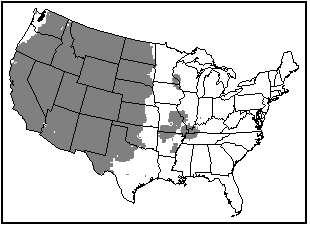 Note from the BPWI Research Nerd: This map shows the Golden Eagle range map, including a section in our state of Wisconsin where wind development is planned.
Note from the BPWI Research Nerd: This map shows the Golden Eagle range map, including a section in our state of Wisconsin where wind development is planned.
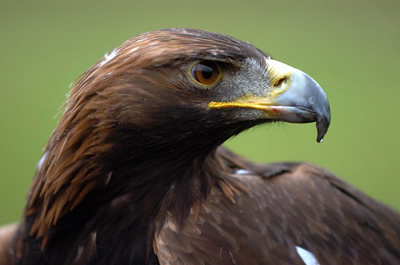 WIND POWER TURBINES AT ALTAMONT PASS THREATEN PROTECTED BIRDS
WIND POWER TURBINES AT ALTAMONT PASS THREATEN PROTECTED BIRDS
Read entire story at the source: Los Angeles Times, www.latimes.com
June 6, 2011
By Louis Sahagun
“It would take 167 pairs of local nesting golden eagles to produce enough young to compensate for their mortality rate related to wind energy production,” said field biologist Doug Bell, manager of East Bay Regional Park District’s wildlife program. “We only have 60 pairs.”
Scores of protected golden eagles have been dying each year after colliding with the blades of about 5,000 wind turbines along the ridgelines of the Bay Area’s Altamont Pass Wind Resource Area, raising troubling questions about the state’s push for alternative power sources.
The death count, averaging 67 a year for three decades, worries field biologists because the turbines, which have been providing thousands of homes with emissions-free electricity since the 1980s, lie within a region of rolling grasslands and riparian canyons containing one of the highest densities of nesting golden eagles in the United States.
“It would take 167 pairs of local nesting golden eagles to produce enough young to compensate for their mortality rate related to wind energy production,” said field biologist Doug Bell, manager of East Bay Regional Park District’s wildlife program. “We only have 60 pairs.”
The fate of the Bay Area’s golden eagles highlights the complex issues facing wildlife authorities, wind turbine companies and regulatory agencies as they promote renewable energy development in the Altamont Pass and across the nation and adds urgency to efforts to make the technology safer for wildlife, including bats, thousands of which are killed each year by wind turbines.
Gov. Jerry Brown in April signed into law a mandate that a third of the electricity used in California come from renewable sources, including wind and solar, by 2020. The new law is the most aggressive of any state.
The development and delivery of renewable energy is also one of the highest priorities of the Interior Department, which recently proposed voluntary guidelines for the sighting and operation of wind farms. Environmental organizations led by the American Bird Conservancy had called for mandatory standards.
The U.S. Fish and Wildlife Service authorizes limited incidental mortality and disturbance of eagles at wind facilities, provided the operators take measures to mitigate the losses by replacing older turbines with newer models that are meant to be less hazardous to birds, removing turbines located in the paths of hunting raptors and turning off certain turbines during periods of heavy bird migration. So far, no wind energy company has been prosecuted by federal wildlife authorities in connection with the death of birds protected by the Migratory Bird Act, the Bald and Golden Eagle Protection Act or the federal Endangered Species Act.
The survival of the Bay Area’s golden eagles may depend on data gathered by trapping and banding and then monitoring their behavior in the wilds and in wind farms.
On a recent weekday, Bell shinnied up the gnarled branches of an old oak to a bathtub-sized golden eagle nest overlooking a canyon about 25 miles south of Altamont Pass.
Two fluffy white and black chicks, blinked and hissed nervously as he scooped them up and placed them into cloth sacks. He attached the sacks to a rope and delicately lowered them 45 feet to the ground.
“As adults, these birds could eventually wind up anywhere in the Western United States or Mexico — that is, if they live that long,” Bell said.
With field biologist Joe DiDonato, he banded the birds’ legs and recorded their vital statistics in a journal that chronicles more than a decade of raptor research in the region. The message is a grim one.
Each year, about 2,000 raptors are killed in the Altamont Pass by wind turbines, according to on-site surveys conducted by field biologists. The toll, however, could be higher because bird carcasses are quickly removed by scavengers.
Environmentalists have persuaded the energy industry and federal authorities — often through litigation — to modify the size, shape and placement of wind turbines. Last year, five local Audubon chapters, the California attorney general’s office and Californians for Renewable Energy reached an agreement with NextEra Energy Resources to expedite the replacement of its old wind turbines in the Altamont Pass with new, taller models less likely to harm birds such as golden eagles and burrowing owls that tend to fly low.
The neighboring Buena Vista Wind Energy Project recently replaced 179 aging wind turbines with 38 newer and more powerful 1-megawatt turbines. That repowering effort has reduced fatality rates by 79% for all raptor species and 50% for golden eagles, according to a study by Shawn Smallwood, an expert on raptor ecology in wind farms.
It remains unclear, however, whether such mega-turbines would produce similar results elsewhere, or reduce fatalities among bats.
Nationwide, about 440,000 birds are killed at wind farms each year, according to the Fish and Wildlife Service. The American Wind Energy Assn., an industry lobbying group, points out that far more birds are killed each year by collisions with radio towers, tall buildings, airplanes, vehicles and in encounters with hungry household cats.
And while “there’s quite a bit of growth to come in wind energy development, it won’t be popping up everywhere,” said attorney Allan Marks, who specializes in the development of renewable energy projects. “That is because you can only build these machines where the wind is blowing. So a lot of the new development will be replacing old facilities in areas such as Cabazon, the Tehachapi Mountains and Altamont Pass.”
Nonetheless, the generating facilities will continue to threaten federally protected species such as eagles and California condors, a successfully recovered species that is expanding its range into existing and proposed wind farms in Kern and Fresno counties.
NextEra Energy’s proposed North Sky River Project calls for 102 wind turbines across 12,582 acres on the east flank of the Piute Mountains, about 17 miles northeast of the Tehachapis. A risk assessment of that project warned that condors spend considerable time soaring within the potential rotor-swept heights of modern wind turbines, which are more than 200 feet tall. It also pointed out that condor roosts are as close as 25 miles away.
“We taxpayers have spent millions of dollars saving the California condor from extinction,” said Gary George, spokesman for Audubon California. “How’s the public going to feel about wind energy if a condor hits the turbines?”
In the meantime, raptors such as golden eagles, American kestrels, red-tail hawks and prairie falcons continue to compete with wind turbines for their share of the winds blowing from the southwest through the Altamont Pass.
Golden eagles weigh about 14 pounds, stand up to 40 inches tall and are equipped with large hooked bills and ice-pick talons. Their flight behavior and size make it difficult for them to maneuver through forests of wind turbine towers, especially when distracted by the sight of prey animals such as ground squirrels and rabbits.
“The eagles usually die of blunt-force trauma injuries,” Bell said. “Once, I discovered a wounded golden eagle hobbling through tall grass, about a quarter mile from the turbine blades that had clipped its flight feathers.”
As he spoke, an adult male golden eagle glided a few yards above the contours of Buena Vista’s sloped grasslands, prowling for prey. It floated up and over a rise, narrowly evading turbine blades as it followed the tantalizing sight of a ground squirrel scurrying through the brush.
Bell sighed with relief. “A wind farm owner once told me that if there were no witnesses, it would be impossible to prove a bird had been killed by a wind turbine blade,” he said. “My response was this: If you see a golden eagle sliced in half in a wind farm, what other explanation is there?”
6/3/11 First comes the wind developer, then comes the met tower, then comes a lifetime of regret AND About that new wind developer poking around Spring Valley
 AN OPEN LETTER FROM A WISCONSIN FARMER WHO REGRETS SIGNING A WIND CONTRACT
AN OPEN LETTER FROM A WISCONSIN FARMER WHO REGRETS SIGNING A WIND CONTRACT
"By signing that contract, I signed away the control of the family farm, and it's the biggest regret I have ever experienced and will ever experience."
-Gary Steinich, Cambria, Wisconsin. June 2011
Sometime in late 2001 or early 2002, a wind developer working for Florida Power and Light showed up near the Wisconsin Town of Cambria looking to get in touch with someone at the Steinich family farm.
He wanted to talk to the landowner about leasing a bit of land for the installation of a met tower. He needed to measure the winds in the area for a possible windfarm and Walter Steinich's land looked like a good place to do it.
The wind developer seemed like a good guy to Mr. Steinich who was in his early 70's at the time. The money seemed good. A met tower didn't seem like a big deal. It was just a tall pole with some guy wires, and it was temporary. Mr. Steinich signed the contract.
That was nearly ten years ago. Mr. Steinich has since passed away and now his son, Gary, runs the farm. He's written an open letter to Wisconsin farmers about his experience with the wind company since then.
Photos below are of access roads and turbine foundations in various farm fields in the Glacier Hils project now under construction in Columbia County, Wisconsin
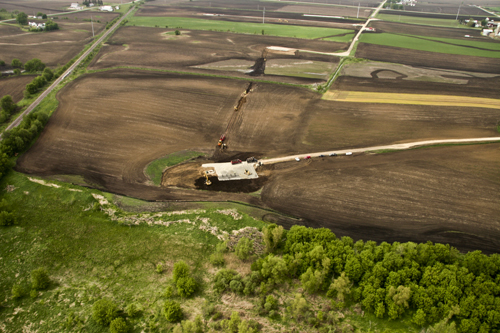 Turbine access road cutting diagonally across field in Glacier Hills project. May 2011
Turbine access road cutting diagonally across field in Glacier Hills project. May 2011
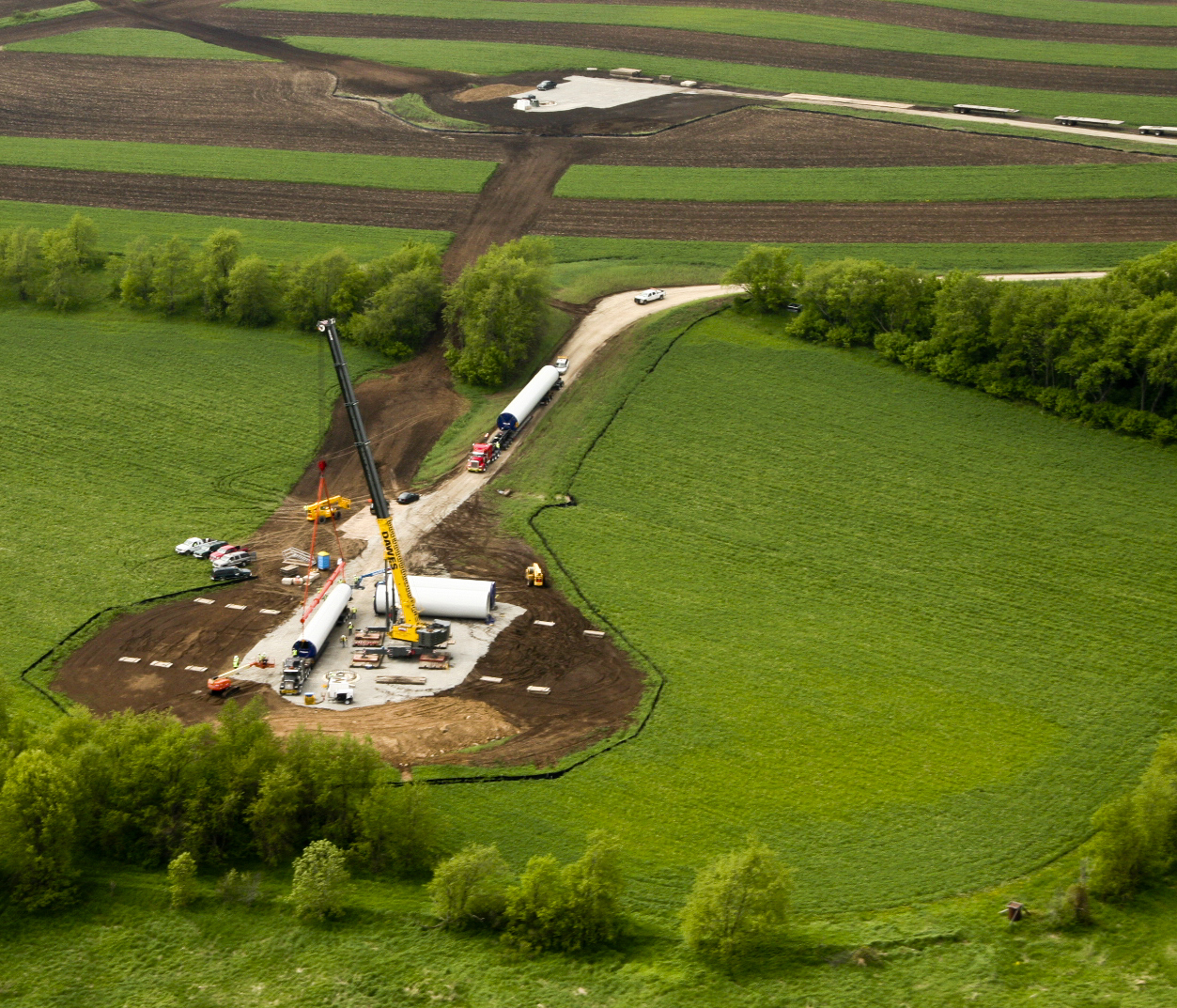
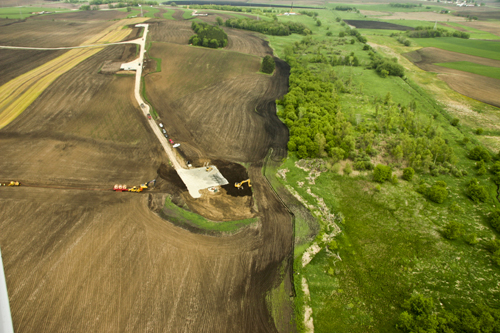
From One Wisconsin Farmer to Another:
This is an open letter to Wisconsin farmers who are considering signing a wind lease to host turbines on your land. Before you sign, I’d like to tell you about what happened to our family farm after we signed a contract with a wind developer.
In 2002, a wind developer approached my father about signing a lease agreement to place a MET tower on our land. My father was in his 70’s at the time. The developer did a good job of befriending him and gaining his trust.
He assured my father that the project wasn’t a done deal and was a long way off. They first had to put up the MET tower to measure the wind for awhile.
He told my father that if the project went forward there would be plenty of time to decide if we wanted to host turbines on our farm. There would be lots of details to work out and paperwork to sign well before the turbines would be built. The developer said my father could decide later on if he wanted to stay in the contract.
In 2003 the developer contacted us again. This time he wanted us to sign a contract to host turbines on our land. We were unsure about it, so we visited the closest wind project we knew of at the time. It was in Montfort, WI.
The Monfort project consists of 20 turbines that are about 300 feet tall and arranged in a straight line, taking up very little farmland with the turbine bases and access roads. The landowners seemed very satisfied with the turbines. But we were still unsure about making the commitment.
We were soon contacted again by the developer, and we told him we were undecided. Then he really started to put pressure on us to sign.
This was in March of 2004, a time of $1.60 corn and $1200 an acre land. It seemed worth it have to work around a couple of turbines for the extra cash. We were told the turbines would be in a straight line and only take up a little bit of land like the ones in Monfort.
And we were also told that we were the ones holding up the project. That all of our neighbors had signed, and we were the last hold-outs. It persuaded us.
What we didn’t know then was the developer was not being truthful. We were not the ‘last hold-out’ at all. In later discussions with our neighbors we found out that in fact we were the very first farmers to sign up. I have since found out this kind of falsehood is a common tactic of wind developers.
My father read through the contract. He said he thought it was ok. I briefly skimmed through it, found the language confusing, but trusted my father's judgment. We didn’t hire a lawyer to read it through with us. We didn’t feel the need to. The developer had explained what was in it.
The wind contract and easement on our farm was for 20 years. By then my dad was 75. He figured time was against him for dealing with this contract in the future so we agreed I should sign it. A few months later, my father died suddenly on Father's Day, June 20th, 2004
After that, we didn’t hear a whole lot about the wind farm for a couple years. There was talk that the project was dead. And then in 2007 we were told the developer sold the rights to the project. A Wisconsin utility bought it.
After that everything changed. The contract I signed had an option that allowed it to be extended for an additional 10 years. The utility used it.
The turbines planned for the project wouldn’t be like the ones in Monfort. They were going to be much larger, 400 feet tall. And there were going to be 90 of them.
They weren’t going to be in a straight row. They’d be sited in the spots the developer felt were best for his needs, including in middle of fields, with access roads sometimes cutting diagonally across good farm land. Landowners could have an opinion about turbine placement but they would not have final say as to where the turbines and access roads would be placed. It was all in the contract.
Nothing was the way we thought it was going to be. We didn't know how much land would be taken out of production by the access roads alone. And we didn't understand how much the wind company could do to our land because of what was in the contract..
In 2008 I had the first of many disputes with the utility, and soon realized that according to the contract I had little to no say about anything. This became painfully clear to me once the actual construction phase began in 2010 and the trucks and equipment came to our farm and started tearing up the field.
In October of 2010 a representative of the utility contacted me to ask if a pile of soil could be removed from my farm. It was near the base of one of the turbines they were putting on my land. I said no, that no soil is to be removed from my farm.
The rep said that the pile was actually my neighbor’s soil, that the company was storing it on my land with plans to move it to another property.
Shortly afterwards I noticed the pile of subsoil was gone.
In November of 2011 I saw several trucks loading up a second pile of soil on my land and watched them exiting down the road. I followed them and then called the Columbia County Sheriff. Reps from the company were called out. I wanted my soil back.
A few days later the rep admitted they couldn’t give it back to me because my soil was gone. It had been taken and already dispersed on someone else's land. I was offered 32 truck loads of soil from a stockpile they had. I was not guaranteed that the soil would be of the same quality and composition as the truck loads of soil they took from my farm.
I was informed by the lawyer for the utility that I had until April 30, 2011 to decide to take the soil. There would be no other offer. Take it or leave it.
I contacted the Public Service Commission for help. The PSC approved the terms of project and I believed the utility was violating those terms. The PSC responded by telling me they could do nothing because the issue involved a private contract between myself and the utility.
They told me my only option was to sue the utility.
My father and I both worked those fields. Watching the way they’ve been ripped apart would sicken any farmer. But what farmer has the time and money it would take to sue a Wisconsin utility?
By signing that contract I signed away the control of the family farm, and it’s the biggest regret I have ever experienced and will ever experience. I have only myself to blame for not paying close enough attention to what I was signing.
We had a peaceful community here before the developer showed up, but no more. Now it’s neighbor against neighbor, family members not speaking to one another and there is no ease in conversation like in the old days. Everyone is afraid to talk for fear the subject of the wind turbines will come up. The kind of life we enjoyed in our community is gone forever.
I spend a lot of sleepless nights wishing I could turn back the clock and apply what I've learned from this experience. Now corn and bean prices are up. The money from the turbines doesn't balance out our crop loss from land taken out of production. The kind of life we enjoyed on our family farm is gone forever too.
I would not sign that contract today. As I write this, the utility is putting up the towers all around us. In a few months the turbines will be turned on and we'll have noise and shadow flicker to deal with. If I have trouble with these things, too bad. I've signed away my right to complain. These are some of the many problems I knew nothing about when I signed onto the project.
If you are considering signing a wind lease, take the contract to a lawyer. Go over every detail. Find out exactly what can happen to your fields, find out all the developer will be allowed to do to your land. Go through that contract completely, and think hard before make your decision.
I can tell you from first hand experience, once you sign that contract, you will not have a chance to turn back.
Gary Steinich
Steinich Farms, Inc.
Cambria, WI
June, 2011
UPDATE: JUNE 5, 2011 Gary Steinich contacted Better Plan to let us know he and the utility have reached an agreement on his soil restoration.
EXTRA CREDIT READING:
It can be found on the PSC Docket for the Glacier HIlls project. [ #6634 CE 302]
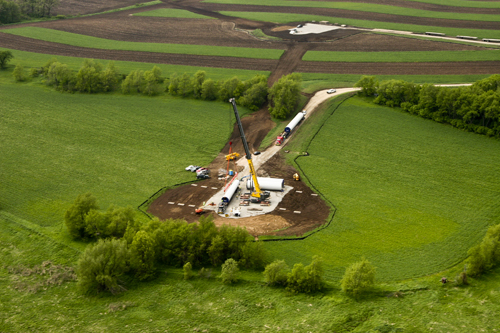
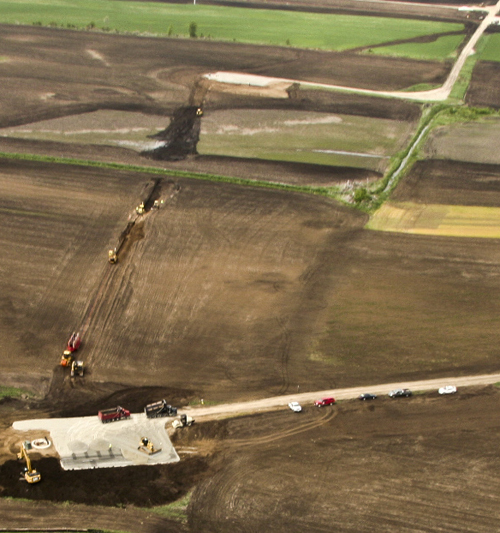
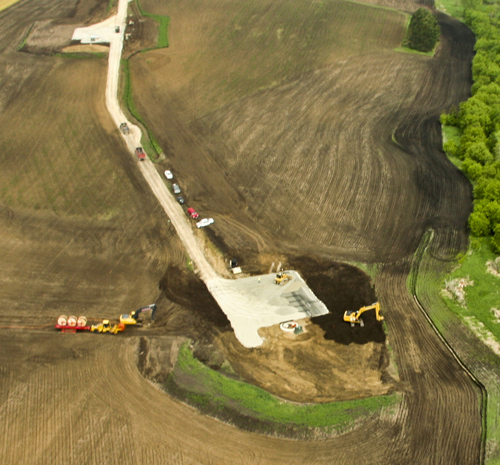
NEXT STORY: From Rock County, WI
SPRING VALLEY CONSIDERING BAN ON WIND TURBINES
SOURCE: The Janesville Gazette, gazettextra.com
June 4, 2011
By GINA DUWE
SPRING VALLEY TOWNSHIP — Town officials in Spring Valley are considering a new moratorium on wind turbines after the largest wind company in North America inquired about town wind ordinances.
The town board will discuss and likely vote on a moratorium at its Monday, June 13, meeting, Clerk Judy Albright said.
Spring Valley is among several area townships that wrote wind moratoriums while new rules to regulate wind projects less than 100-megawatts are decided at the state level.
Town officials discovered their previous moratorium expired Dec. 1 after Ted Weissman of NextEra Energy recently inquired about ordinances related to wind development and the process for placing a met tower.
A met tower gathers weather data to help wind developers determine if a site is good for development.
Weissman said he couldn’t comment but the company was looking at the area and hadn’t made any decisions. A company spokesman, however, said NextEra is not pursuing a met tower in Rock County.
Spokesman Steve Stengel said Weissman might have conducted some inquiries, but “we are not proposing it at this point,” he said. “What may or may not happen in the future (is) all speculation.”
NextEra owns and operates two wind farms in Wisconsin: 36 turbines at Butler Ridge Wind Energy Center in Dodge County and 20 turbines at Montfort Wind Energy Center in Iowa County.
Neighboring townships Magnolia and Union became possible sites for wind turbines a few years ago, and one met tower was placed in each town to gather data.
A spokeswoman for Acciona, the company that eyed those townships, said this week it is not pursuing “the early stage development project in Union and Magnolia. This enables (Acciona) to focus efforts and resources on other projects that are a better fit for their portfolio.”
Developers would be interested in hooking into the major transmission line that runs east-west through the northern part of Spring Valley, town officials said.
Smaller wind projects are permitted through local ordinances until lawmakers enact statewide rules.
Under state law, the Public Service Commission has to develop the rules, and a committee worked through most of last year to write the rules. When the rules were set to take effect in March, Republican lawmakers suspended them. It’s now up to legislators to approve new rules by May 2012 or the suspended rules would go into effect, a PSC spokesman said.
Republican Sen. Frank Lasee has proposed a bill that would add additional requirements to the PSC rules. The bill was referred to the Committee on Energy, Biotechnology and Consumer Protection, but no hearing is scheduled.
If you go
The town board will discuss and likely vote on a wind moratorium at its 7 p.m. meeting Monday, June 13, at the Orfordville Fire Department, 173 N. Wright St., Orfordville.
5/17/11 Why won't NextEra AKA Florida Power and Light give up their turbine related bird and bat kill numbers? Why won't they agree to cooperate? And who is going to do anything about it? AND Yet another blade accident being called isolated and one of a kind by wind company
FROM PENNSYLVANIA
Note from the BPWI Research Nerd: The wind turbine related bird and bat kill rates in Pennsylvania have made news several times in the past few years with numbers considered to be shockingly high.
Sadly these numbers are far less than the turbine related kill rates in the state of Wisconsin
In a recent Green Bay Press Gazette Article , turbine related bat kills in Wisconsin were reported to be as high as 50 per turbine per year, a number that is not not only ten times what the wind companies say is the national average, but it is considered to be unsustainable. To the best of our knowledge the bat kill rates from wind turbines in our state are the hightest in North America. And to the best of our knowledge no one is doing anything about it.
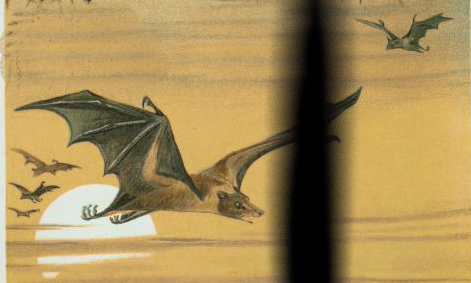
BLOWING' IN THE WIND
READ ENTIRE STORY AT THE SOURCE: Outdoor Trails, Staff Writer, lancasteronline.com
May 16, 2011
By AD CRABLE,
Since 2007, 73 percent of the owners of wind projects in the state have signed the Wind Energy Voluntary Cooperation Agreement.
Among the notable exceptions is Florida Power & Light and its subsidiaries, which have the most turbines in the state. High bat mortality has been found at some of them.
Are proliferating wind turbines killing a large number of birds in Lancaster County and Pennsylvania? No, say the Game Commission and power companies. You’ll have to take their word for it.
Every other day since March 1, a searcher has walked a grid pattern under the two new wind turbines on Turkey Hill, looking for the carcasses of birds that may have been killed by the turning blades.
So, have there been any bats, tundra swans, birds of prey or endangered songbirds unfortunately whacked by the 135-foot-long blades?
Project owner PPL Renewable Energy and the Pennsylvania Game Commission know, but they’re not telling.
Certainly there is no reason to think many birds are being sliced and diced at the Manor Township site.
But shouldn’t the public be allowed to know if there are? After all, the turbines were partially built with federal stimulus funds, your tax dollars.
How about bird scientists with the Pennsylvania Biological Survey, the Game Commission’s independent scientific advisers who monitor the state’s bird populations? Should they be privy to the mortality rate at Pennsylvania’s proliferating wind turbines?
The group certainly thinks so, but the body count is not shared with them, either.
Instead, the Game Commission, apparently to gain turbine owners’ participation, agree to share information with each other but not anyone else.
The agreement states, “It is understood between the parties that information resulting from the cooperator’s compliance with this agreement shall be treated with the highest affordable level of confidentiality available unless otherwise agreed to in writing by both parties.”
When I requested the results of dead bird searches at the Turkey Hill project, PPL said it “was following the Game Commission’s protocol in keeping it in confidence.”
This is the questionable state of affairs several years into wind energy taking hold in Pennsylvania.
The Game Commission is responsible for the state’s birds and mammals.
As wind technology advanced like a sudden gust of wind several years ago, it became clear there were no comprehensive regulations in place to protect wildlife.
Working with energy companies — and at least initially independent advisers such as the PBS — the Game Commission fashioned a voluntary agreement designed to avoid, minimize and mitigate impacts on wild animals.
Mainly, we’re talking about birds, and especially bats, which seem to be most prone to running into turbine blades.
Since 2007, 73 percent of the owners of wind projects in the state have signed the Wind Energy Voluntary Cooperation Agreement.
Among the notable exceptions is Florida Power & Light and its subsidiaries, which have the most turbines in the state. High bat mortality has been found at some of them.
In addition to working with the Game Commission to reduce effects on birds, wind companies agree to do pre-construction surveys of birds and animals at proposed sites, and to count any mortality from turbines for two years after startup.
That advance scouting of bird habits and pooling of information has been effective, according to the Game Commission.
Turbines have been moved, bat-roosting locations have been pinpointed and protected, and even a few turbine sites have been abandoned, the agency says.
Indeed, at Turkey Hill, the number of turbines was reduced from four to two, the two turbines that were built were set back farther from the Susquehanna, vegetation is kept close-cropped so as not to attract predators and electrical lines were buried to discourage perching birds near the turbines — all because of pre-construction wildlife surveys, points out Steven Gabrielle of PPL.
“We’re not required to do this. We’re spending a lot of time and money to do this because we respect preserving the environment,” Gabrielle says.
Then why not prove it by making available the results of all those commendable approaches, I say.
Another who is very unhappy with the no-tell approach is George Gannon, a professor of biology and ecology at Penn State-Altoona who worked with the Game Commission in setting up the wind energy cooperative agreement on behalf of the PBS.
He voices this complaint, “There is no independent scientific peer review of anything submitted by the wind companies, as these data are not permitted to be seen by anyone else.
“This is contrary to the very basic premise of how good science works.”
He mentions a 2009 case in West Virginia where a federal court found that a wind company’s hired bat consultants reached a conclusion favorable to the client, but turned out to be inaccurate when the actual data was reviewed.
“It was Ronald Reagan who said ‘trust but verify,’ ” continues Gannon. “Unfortunately, with the system in place, the PGC cannot verify the work submitted by wind developers and the people of Pennsylvania cannot verify either the developers or the PGC.”
In 2007, a PBS wind energy and bats subcommittee accused the Game Commission of “side-stepping” input and review from the PBS in developing the cooperative agreement with wind energy developers.
The group, which included two PGC biologists, unanimously urged the agency to abandon the protocol used in evaluating bats and bat mortality at wind turbine sites and to “develop a more realistic, more meaningful, and more scientifically sound protocol.”
The current agreement “puts the interests of the wind industry before the interests of the Commonwealth,” the PBS group said.
The Game Commission recently issued its second wind energy summary report that includes 150 wildlife surveys and research under the voluntary agreement from 2007 through June 30, 2010.
Among the tidbits (no names, of course):
The number of bat deaths comes out to 24.6 per turbine per year.
Among birds, the average death rate was 3.9 per turbine per year.
Three state-endangered birds were killed: two blackpoll warblers and one yellow-bellied flycatcher. All three were deemed to be migrants passing through and not from local breeding populations.
No large mortality events were recorded, defined as more than 50 carcasses found in a single day.
Surveys conducted as part of the agreement have located new locations of state- and federally-listed bats.
As part of the cooperative agreement, the Game Commission has said it will not pursue liability against cooperating wind turbine companies that kill birds, as long as they comply with the conditions of the agreement.
The agency is proud of its efforts.
“The Cooperative Agreement has allowed Pennsylvania to become one of the national leaders for determining and addressing wildlife impacts from wind energy development, as well as providing critical data needed to address future wind energy project proposals,” said William Capouillez, director of the agency’s Bureau of Wildlife Habitat Management.
With some transparency on behalf of the Game Commission and wind turbine operators, maybe the public would come to the same conclusion.
FROM NORTH DAKOTA
IBERDROLA SAYS FALLING SUZILON BLADES WERE A ONE-TIME ACCIDENT
READ THE WHOLE STORY AT THE SOURCE: Bloomberg, www.bloomberg.com
May 18, 2011
By Natalie Obiko Pearson,
Iberdrola SA (IBE), the world’s biggest renewable energy producer, has found that falling blades from a Suzlon Energy Ltd. (SUEL) generator at a U.S. wind farm was a one-off accident unrelated to the turbine’s history of cracked blades.
“This type of failure is a singular event,” said an Iberdrola report, a copy of which was mailed by Suzlon to Bloomberg News, on a joint investigation by the two companies into the incident.
Iberdrola suspended operations at the 150-megawatt wind farm in Rugby, North Dakota after blades from a Suzlon S88 turbine fell from their mount, the company said on March 21. The same model suffered cracked blades starting in 2007, which had prompted a $100 million global retrofit program by India’s largest maker of windmills for power production.
The accident at Rugby was caused by the failure of a bolt connecting the rotor assembly to the nacelle, the report said. Stress may have been put on the bolt because of a misalignment of the connecting surfaces between the rotor hub and mainshaft flange, it said.
All 70 turbines and 3,360 bolts were inspected and seven bolts replaced as a precaution before Iberdrola and Suzlon agreed the site was safe to return to service, it said.
“Suzlon, who is permanently onsite, will perform additional checks in conjunction with regular maintenance activities,” it said.
Suzlon has more than 2,000 sets of S88 turbines operating worldwide and its global fleet are performing above industry standards, spending only 3 percent in downtime for maintenance, the company said in an e-mail.
Suzlon shares plummeted 83 percent between the time it announced the defect in January 2008 and completed retrofitting in October 2009 as customers, including Rosemead, California- based Edison International (EIX), canceled orders.
